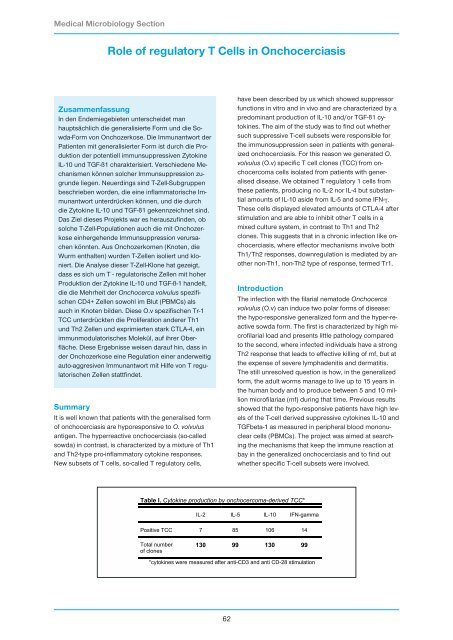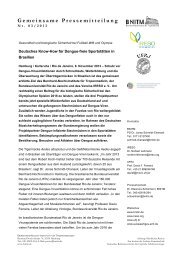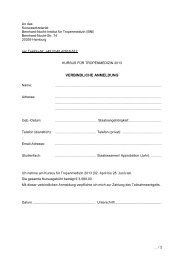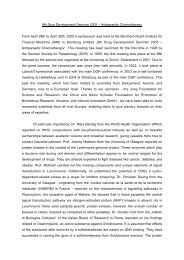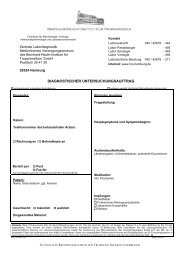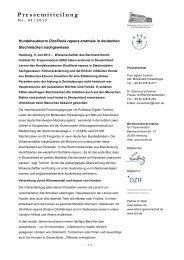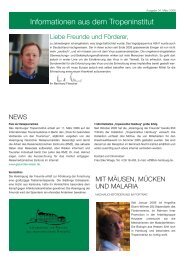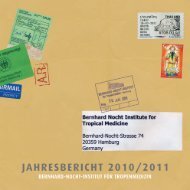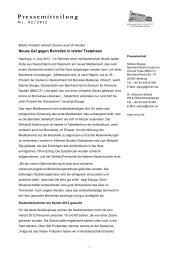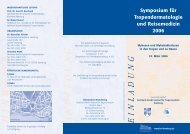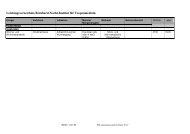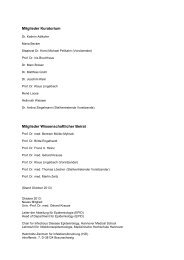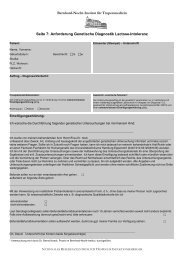Research Group Heussler (Malaria I) - Bernhard-Nocht-Institut für ...
Research Group Heussler (Malaria I) - Bernhard-Nocht-Institut für ...
Research Group Heussler (Malaria I) - Bernhard-Nocht-Institut für ...
Create successful ePaper yourself
Turn your PDF publications into a flip-book with our unique Google optimized e-Paper software.
Medical Microbiology Section<br />
Role of regulatory T Cells in Onchocerciasis<br />
Zusammenfassung<br />
In den Endemiegebieten unterscheidet man<br />
hauptsächlich die generalisierte Form und die Sowda-Form<br />
von Onchozerkose. Die Immunantwort der<br />
Patienten mit generalisierter Form ist durch die Produktion<br />
der potentiell immunsuppressiven Zytokine<br />
IL-10 und TGF-ß1 charakterisiert. Verschiedene Mechanismen<br />
können solcher Immunsuppression zugrunde<br />
liegen. Neuerdings sind T-Zell-Subgruppen<br />
beschrieben worden, die eine inflammatorische Immunantwort<br />
unterdrücken können, und die durch<br />
die Zytokine IL-10 und TGF-ß1 gekennzeichnet sind.<br />
Das Ziel dieses Projekts war es herauszufinden, ob<br />
solche T-Zell-Populationen auch die mit Onchozerkose<br />
einhergehende Immunsuppression verursachen<br />
könnten. Aus Onchozerkomen (Knoten, die<br />
Wurm enthalten) wurden T-Zellen isoliert und kloniert.<br />
Die Analyse dieser T-Zell-Klone hat gezeigt,<br />
dass es sich um T - regulatorische Zellen mit hoher<br />
Produktion der Zytokine IL-10 und TGF-ß-1 handelt,<br />
die die Mehrheit der Onchocerca volvulus spezifischen<br />
CD4+ Zellen sowohl im Blut (PBMCs) als<br />
auch in Knoten bilden. Diese O.v spezifischen Tr-1<br />
TCC unterdrückten die Proliferation anderer Th1<br />
und Th2 Zellen und exprimierten stark CTLA-4, ein<br />
immunmodulatorisches Molekül, auf ihrer Oberfläche.<br />
Diese Ergebnisse weisen darauf hin, dass in<br />
der Onchozerkose eine Regulation einer anderweitig<br />
auto-aggresiven Immunantwort mit Hilfe von T regulatorischen<br />
Zellen stattfindet.<br />
Summary<br />
It is well known that patients with the generalised form<br />
of onchocerciasis are hyporesponsive to O. volvulus<br />
antigen. The hyperreactive onchocerciasis (so-called<br />
sowda) in contrast, is characterized by a mixture of Th1<br />
and Th2-type pro-inflammatory cytokine responses.<br />
New subsets of T cells, so-called T regulatory cells,<br />
Table I. Cytokine production by onchocercoma-derived TCC*<br />
62<br />
have been described by us which showed suppressor<br />
functions in vitro and in vivo and are characterized by a<br />
predominant production of IL-10 and/or TGF-ß1 cytokines.<br />
The aim of the study was to find out whether<br />
such suppressive T-cell subsets were responsible for<br />
the immunosuppression seen in patients with generalized<br />
onchocerciasis. For this reason we generated O.<br />
volvulus (O.v) specific T cell clones (TCC) from onchocercoma<br />
cells isolated from patients with generalised<br />
disease. We obtained T regulatory 1 cells from<br />
these patients, producing no IL-2 nor IL-4 but substantial<br />
amounts of IL-10 aside from IL-5 and some IFN-γ.<br />
These cells displayed elevated amounts of CTLA-4 after<br />
stimulation and are able to inhibit other T cells in a<br />
mixed culture system, in contrast to Th1 and Th2<br />
clones. This suggests that in a chronic infection like onchocerciasis,<br />
where effector mechanisms involve both<br />
Th1/Th2 responses, downregulation is mediated by another<br />
non-Th1, non-Th2 type of response, termed Tr1.<br />
Introduction<br />
The infection with the filarial nematode Onchocerca<br />
volvulus (O.v) can induce two polar forms of disease:<br />
the hypo-responsive generalized form and the hyper-reactive<br />
sowda form. The first is characterized by high microfilarial<br />
load and presents little pathology compared<br />
to the second, where infected individuals have a strong<br />
Th2 response that leads to effective killing of mf, but at<br />
the expense of severe lymphadenitis and dermatitis.<br />
The still unresolved question is how, in the generalized<br />
form, the adult worms manage to live up to 15 years in<br />
the human body and to produce between 5 and 10 million<br />
microfilariae (mf) during that time. Previous results<br />
showed that the hypo-responsive patients have high levels<br />
of the T-cell derived suppressive cytokines IL-10 and<br />
TGFbeta-1 as measured in peripheral blood mononuclear<br />
cells (PBMCs). The project was aimed at searching<br />
the mechanisms that keep the immune reaction at<br />
bay in the generalized onchocerciasis and to find out<br />
whether specific T-cell subsets were involved.<br />
IL-2 IL-5 IL-10 IFN-gamma<br />
Positive TCC 7 85 106 14<br />
Total number<br />
of clones<br />
130 99 130 99<br />
*cytokines were measured after anti-CD3 and anti CD-28 stimulation


